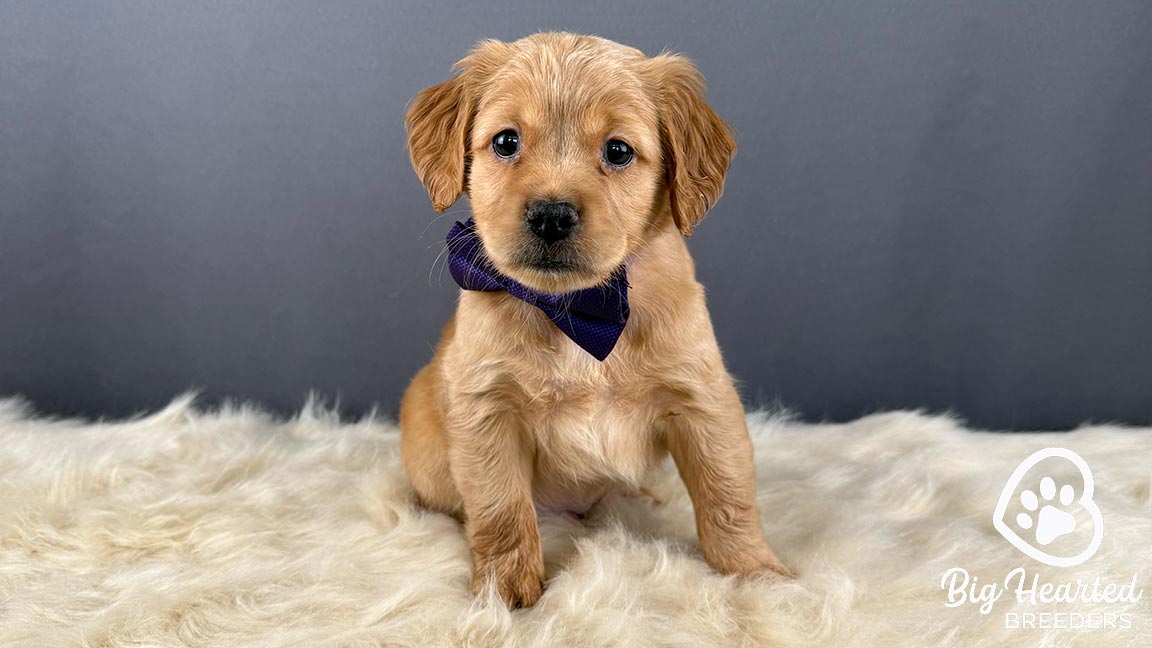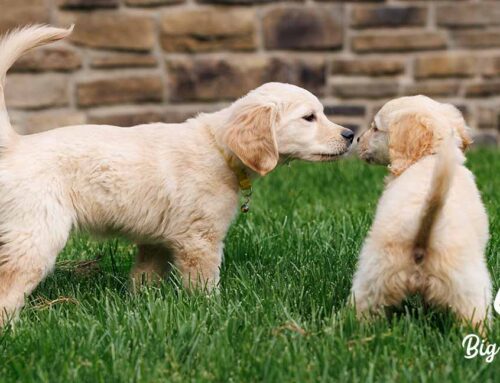Tear Stains in Dogs: What They Are and How to Help
Tear Stains in Dogs: What They Are and How to Help
If you have ever noticed reddish brown streaks under your dog’s eyes, you are not alone. These marks, called tear stains, are very common, especially in puppies with lighter coats. While they are not usually dangerous, they can be a sign of irritation or other issues that deserve attention.
At Big Hearted Breeders, where we raise Mini Golden Retriever puppies in a clean, loving, and health-focused environment, we are often asked about tear stains by new puppy families. Over the years we’ve learned that stains are usually manageable with the proper care and can often be prevented from becoming a long-term concern.
In this guide, we’ll share what tear stains are, why they happen, and the safe, practical steps you can take to keep your puppy’s face fresh and healthy. This article will help you with real solutions we’ve used ourselves, so you can feel confident in caring for your puppy.

What Are Tear Stains?
A tear stain is a reddish or dark colored mark that forms beneath a dog’s eyes. It happens when tears spill over from the eye and the moisture sits on the fur. Over time, this moisture contains compounds like porphyrins, a substance in saliva and tears, that cause discoloration.
Tear stains are most visible on dogs with light colored coats, which is why they show up so easily on Mini Golden Retrievers and similar breeds. Though usually harmless, tear stains can sometimes signal a bigger issue, such as allergies, blocked tear ducts, or an eye infection.
Quick summary: Tear stains are caused by excess tearing and the natural compounds in tears. They are most often cosmetic but should not be ignored if they suddenly worsen or come with other symptoms like eye redness or irritation.

Why Do Dogs Get Tear Stains?
There is no single reason a dog develops a tear stain. In our experience as breeders, the cause can range from something simple like teething to more complex issues.
Common causes include:
- Excessive tearing from genetics or small tear ducts
- Allergies to food or environmental triggers
- Teething in young puppies
- Ear infections or eye irritation
- Diets that are not balanced or high in fillers
Sometimes it can be trial and error to figure out what is causing your puppy’s stains. That’s why we recommend approaching the problem with both good nutrition and gentle care.
A Breeder’s Experience with Tear Stains
When we raise Mini Golden Retriever puppies, we always keep a close eye on their overall health. Tear stains are one of the first things new families ask about when they see their fluffy white or cream-coated puppy with reddish streaks under their eyes.
We’ve found that stains often show up around the same time puppies are teething. This is a sensitive stage when their immune system and digestion are still developing. With the proper adjustments, stains usually fade as the puppy grows.
For example, we once had a sweet puppy named Daisy who developed heavy staining at around 12 weeks old. Her family was concerned, but we worked with them on two key changes: switching to a high-quality diet and using safe tear stain solutions. Within a few months, Daisy’s face was bright and clean again. Stories like hers remind us that stains are often manageable with patience and the right care.
How to Deal with Tear Stains
The good news is that tear stains can be improved. Here are the methods we trust and share with our puppy families.

Nutrition Matters
Poor-quality food can contribute to staining. A clean, balanced diet with limited fillers helps reduce irritation that may cause excess tearing. At Big Hearted Breeders, we partner with pawTree for nutrition and wellness. Their tear and saliva stain solution and natural chews are specifically designed to target staining from the inside out.
Keep the Face Clean
Gently wiping your dog’s face daily with a soft, damp cloth prevents moisture buildup. Some owners use pet-safe wipes, but warm water works well, too. Consistency is more important than fancy products.
Rule Out Allergies
If stains appear suddenly, consider whether something new has been introduced, such as a food change or environmental factor like pollen. A veterinarian can test for allergies and provide guidance.
Grooming Routine
Regular grooming around the eyes helps keep fur short and clean, reducing the chances of moisture sitting on the hair.
Real Life Tip from Our Puppies
One of the most effective routines we recommend to new puppy parents is combining daily eye wiping with pawTree’s tear stain support. We’ve seen dramatic improvements in families who stuck with this simple approach for a few weeks.
For instance, one family shared how worried they were about their puppy looking “messy” in photos. After using pawTree’s chews and being consistent with cleaning, they happily reported that not only did the stains fade, but their puppy’s coat looked shinier overall.

When to See a Veterinarian
Although most tear stains are cosmetic, there are times when you should call your vet.
Seek help if you notice:
- Swelling or redness around the eyes
- A sudden increase in tearing
- A bad odor coming from the face
- Stains combined with scratching or discomfort
These signs could mean an infection or blocked tear ducts that need professional treatment.
Living with Tear Stains: A Loving Perspective
At the end of the day, tear stains are not a reflection of how well you care for your puppy. They are simply a natural occurrence in many breeds. What matters most is your dog’s comfort and overall health.
We remind our families that a puppy with tear stains is still the same happy, healthy companion, full of love and joy. With patience and the right tools, most stains can be significantly reduced over time.

FAQ About Tear Stains
What is the main cause of tear stains?
Tear stains are most often caused by excess tearing, which leaves behind natural compounds that stain the fur.
Do tear stains hurt my dog?
Most of the time, no. They are usually cosmetic, but if they come with irritation, it’s worth checking with a vet.
Can diet really help?
Yes. A clean, balanced diet can reduce triggers for staining. Many families notice improvements after switching to higher-quality food.
How long does it take to see results with tear stain treatments?
It can take a few weeks of consistent care before stains start to fade. Patience is key.
Are pawTree tear stain products safe?
Yes. pawTree’s tear and saliva solution and chews are safe, natural, and designed to support dogs from the inside out.
Final Thoughts
Tear stains are common, especially in puppies with lighter coats, but they don’t have to be permanent. By focusing on nutrition, consistent cleaning, and safe solutions like pawTree’s support products, you can keep your puppy looking and feeling their best.
At Big Hearted Breeders, we believe every puppy deserves a fresh start in life, surrounded by love, health, and care. Tear stains may come and go, but the joy of raising a happy, healthy puppy will always shine brighter.





